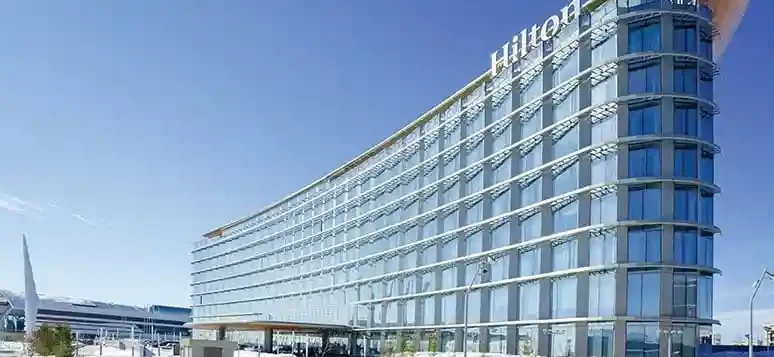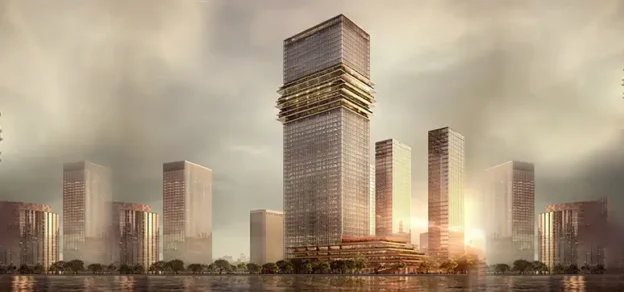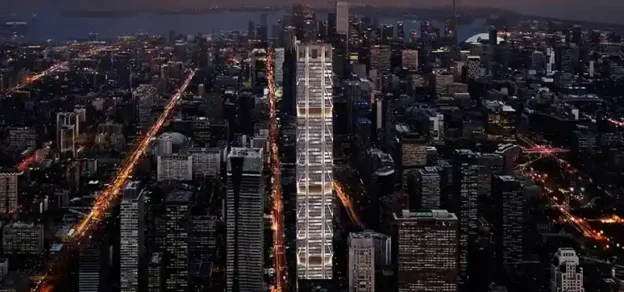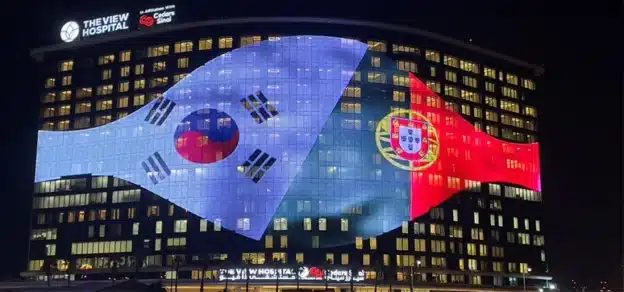Developing the hotel façade was an opportunity to respond to such new Iconic central piece for Astana taking advantage of its location and amplifying its impact on the public realm.
The design process was geared towards taking maximum benefits from the Kazakhstan Pavilion’s presence. The façade of the hotel was curved toward the sphere, to focus on it. In doing so, another plane at the public realm was created where this new Astana Icon can be reflected and be celebrated. But, it was not just one geometrical move. Every “viewing room” or hotel could adjust its placement to look straight into the sphere. The hotel was designed as a textured canvas to direct views room by room and in the process reflect and amplify the presence of the Sphere on the site.
The ballroom and amenities pavilion’s smaller scale and softer language better integrates with the surrounding park. It is mostly solid metal wall surfaces slope down to reduce direct solar radiation on its interior spaces. The walls are carved with minimal window areas to allow for daylighting and views where necessary.
The Congress Center, developed next to the ballroom pavilion and at the same time relates to it with a similar design language. At the top, the roof of the pavilion opens to frame a landscaped terrace for used primarily during the warmer time of the year. This open area offers a great view towards the new residential neighbourhoods.
Exterior Details
From the technical point of view, the main hotel tower exterior wall consists of a unitised triple insulated butt-glazed curtain wall system. Operable windows are included in typical walls to take advantage of natural ventilation during the warmer parts of the year. From the design team’s point of view, allowing natural ventilation during the warmer months in Astana was an opportunity to improve the comfort levels for the users. It also potentially lowers energy use by reducing the need of cooling during part of the year.
Some parts of the project teams might see the need of natural ventilation and as an additional investment and operational cost. However, its user’s views should be more strongly taken into account. Comfort levels are significantly enhanced physically and psychologically by allowing users to customize their space and make it work as per their preferences. Inside the room, guests may want to hear the sounds of the street, listen to the birds or the sound of fresh air moving into their space. Based on promoting the adjustability of the built environments, it is worth pushing for the incorporation of openable panels.
A continuous horizontal shading element was also added to add shading to the overall window wall glass system to increase comfort and add a level of texture to the façade. Between the two hotel room sides, a 2-way stainless steel cable wall system spans the 9-story tall atrium space. The vertical row of rooms at the edges of the cable net wall have balconies which are designed to visually hold the atrium wall located in between them. The balconies give these premium corner rooms the amenity of outdoor space.
Insulated clear glass panels provide for an efficient thermal barrier allowing daylight and views to flow into the interior space. Between the roof and the main hotel mass, a 4m tall clerestory designed with triple insulated glass brings in indirect daylighting deep into the space reflected by the warm wood ceiling. The sculptural roof cantilevers over the edges of the hotel and is cladded with aluminum panels with an underside that is made up of wood composite panels.
In keeping with the principles of the overall Expo site, strict insulation values were given to the building envelope including a U-value of .8 w/m2K for the glass façade areas, and .15 w/m2K for the solid façade areas – resulting in a design savings of over 60% versus a typical baseline hotel building.
Fact File :
Client: It Engeneering
Architect: AS+GG
Structural Consultant: STUDIO ALTIERI S.p.A (Italy)
Façade Consultant: AS+GG
Commencement Date: December 2013 (design process)
Completion Date: April 2015 (design process)
Area: 51,200 m2














